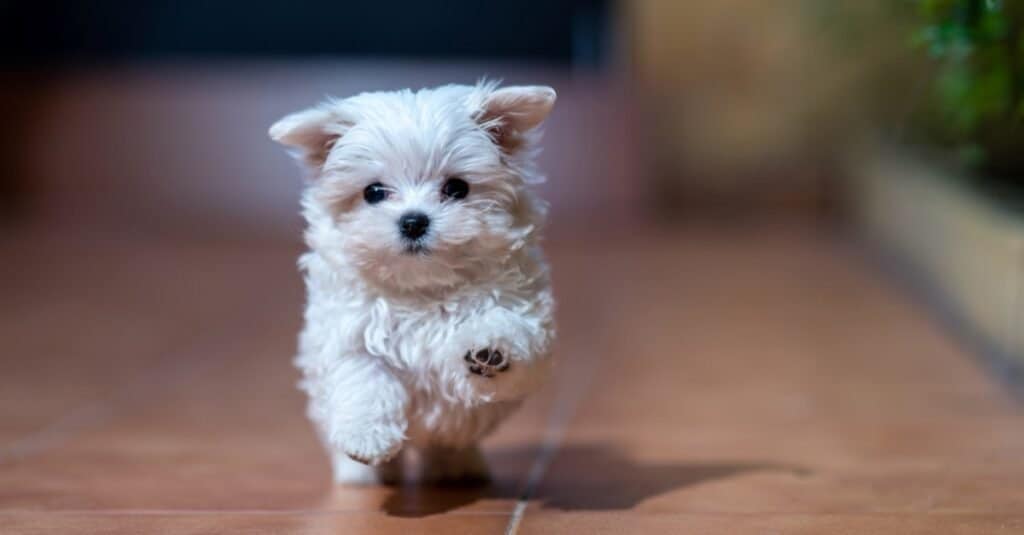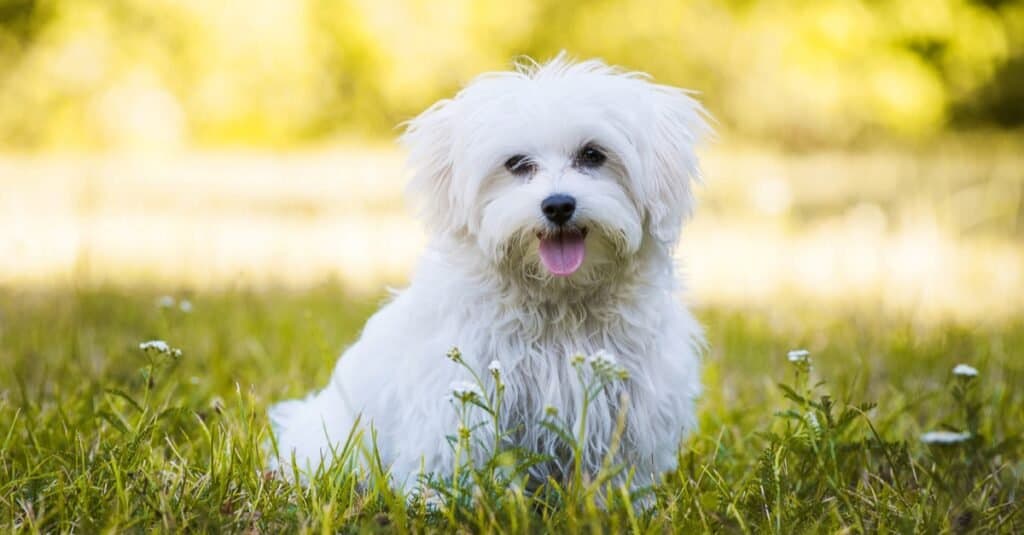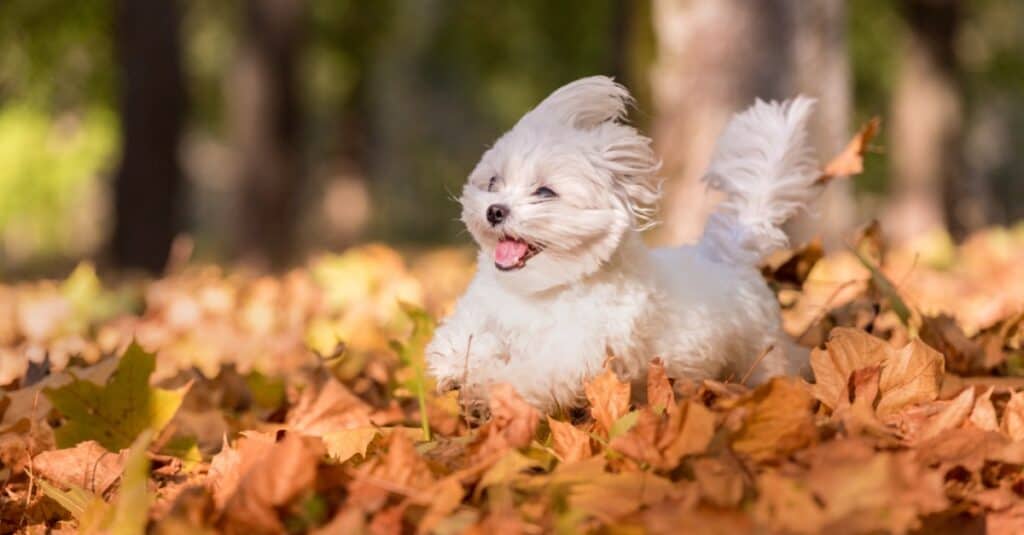Maltese dogs have long, flowing coats. You might wonder, do dogs with fur this magnificent shed? Or perhaps you’ve been told they’re a hypoallergenic breed and want to know the truth.
Maltese are considered a non-shedding breed, which means they shed less than other dogs. This is because they have hair rather than fur, and they shed around the same amount as a human. You’ll find strands of hair now and again, but not clumps.
Don’t let this fool you, though—these pups require a lot of grooming to maintain their beautiful coats. If you’re not looking for a low-maintenance breed, though, and just want your dog to be low-shed or hypoallergenic, the Maltese might be the right dog for you.
Keep reading to learn more about Maltese pups, how much they shed, and how to care for their coats.
Maltese Coat Characteristics
| Coat Length | Long |
| Shedding Frequency | Low |
| Grooming Needs | Comb fur daily |
| Fur or Hair? | Hair |
| Hypoallergenic? | Yes |
Are Maltese Hypoallergenic?

Maltese dogs are hypoallergenic.
©iStock.com/Tatiana
Maltese dogs are hypoallergenic and non-shedding. However, this might not mean what you think it means!
They have a single coat of human-like hair rather than fur. This hair sheds like our own, but not plentifully like dogs with fur. This means you’ll still find strands of long, Maltese fur around the house—but not much of it.
In addition, no dog is completely hypoallergenic. If you’re allergic to dogs, it’s possible that a Maltese will still trigger your allergy symptoms. It gives off fewer allergens than other breeds, which makes it possible for some dog lovers with allergies to have it in the home with little to no reaction.
I recommend seeing some Maltese in person before committing to adoption. This way, you’ll know beforehand if your symptoms are still unmanageable.
Are Maltese Heavy Shedders?
Maltese dogs shed very little, but you might notice some hairs around the house—just like you find your own hair from time to time. Because Maltese hairs are light in color, they may stand out against your floors and furniture—but a quick sweep or vacuuming should eliminate the problem!
Do Maltese Need Haircuts?
Maltese hair grows continuously, like human hair. You might’ve seen a Maltese with hair to the floor in a dog show before, but most people choose to keep their pups clipped short.
This is because that long, flowing coat is difficult to maintain. Some people also prefer the look of a Maltese with a short haircut!
If you don’t cut your pup’s hair on your own, it’ll need to see a groomer regularly to keep it short. This is another expense that you should keep in mind before adopting one of these cuties.
Do Maltese Smell?

Maltese dogs can smell if they haven’t been bathed or have a health problem.
©Francisco Gomez Perpinan/Shutterstock.com
Maltese dogs don’t tend to smell, but they can if they haven’t been bathed or have a health problem.
Using a dog shampoo to regularly bathe your Maltese can help keep its coat healthy and prevent odor. Cleaning its ears and teeth will also help to eliminate smells.
If your Maltese smells even after it has been groomed, visit a veterinarian to rule out health conditions. Odors can indicate skin infections, ear infections, or dental problems, depending on where the stench is coming from.
Smaller dogs can also be more prone to issues with their anal glands, which can become impacted and must be expressed by a veterinarian. This can become very smelly, but not all Maltese will have problems. Most dogs are able to express their anal glands by themselves when they poop.
How to Groom a Maltese
To groom your Maltese, you’ll need to do the following:
- Comb the coat thoroughly once a day
- Trim its hair as desired
- Bathe and condition your pup’s coat regularly
- Trim your Maltese’s nails once a month
- Clean its ears once monthly or as recommended by your veterinarian
- Brush its teeth daily, or as often as possible
Below, we’ll dive into the details and teach you how to groom your Maltese step by step. We’ll also talk about how to incorporate routine health checks into your routine, which can help you to notice health problems sooner.
Comb through Their Coat Daily
Unless your Maltese’s coat is cut very short, it’ll need to be combed through daily. Use a double-sided wire comb for the best results. Start with the side with the most spacing, and then use the finer comb to finish.
Gently brush through your Maltese’s coat, making sure to part its fur down to the skin. Use this time to check for any pests, debris, or skin irritation. Brushing down to the skin will also ensure your pup’s coat doesn’t mat.
Be sure to comb everywhere, including common problem areas like the ears, armpits, and thighs.
Never try to tug through tangled fur. Instead, work through it with your fingers. If needed, gently trim away the tangled fur.
If your Maltese has mats close to the skin, use the comb to block the skin before cutting the mats away with sharp, clean scissors.
Another option is to shave your Maltese with dog clippers or contact a dog groomer to do so for you. This may be the only way forward if your Maltese has many large mats.
Trim Their Hair as Needed

Maintain the coat of your Maltese well, regardless of its length.
©Dora Zett/Shutterstock.com
It’s up to you whether you keep your Maltese’s fur long or trim it shorter. The important thing is to maintain the coat well, regardless of its length.
If you keep your Maltese’s fur short, be sure to schedule regular appointments with your groomer or keep up with it at home. It can quickly grow out of control if you allow it to grow out without combing it daily!
You might also choose to keep certain areas of your Maltese trimmed short for convenience. For instance, many people prefer the fur between the toes cut short to keep the feet cleaner. Your Maltese might also appreciate a shorter haircut on its head to keep its hair from blocking its vision!
Bathe and Condition Your Maltese
To keep your Maltese’s coat clean and healthy, it’ll need to be bathed regularly. This will prevent its hair from becoming greasy or dirty.
How often to bathe a Maltese is debated, with some saying it should be bathed once every 1-2 weeks and others saying to wait 3-4 weeks to avoid damaging the coat or drying out your dog’s skin.
No matter how often you choose to bathe your pup, it’s a good idea to invest in a high-quality dog shampoo that’s gentle on its skin. You should also condition your Maltese’s hair with a conditioner made for dogs.
In-between baths, dry dog shampoo can be used to give your Maltese’s hair a touch-up and prevent odors. However, you might find it’s unneeded, especially if your pup spends most of its time indoors.
During bath time, you can also check over your dog’s body for any abnormal lumps. It’s also a good time to wipe away any debris by the eyes and trim the fur nearby to remove tear stains.
Trim Their Nails at Least Once Monthly
Maltese nails grow quickly, so it’s important to stay on top of it. Trimming your dog’s nails at least once a month will keep them from curling into their paw pads, getting stuck on objects, or snapping by themselves and causing your dog pain.
You can also trim them more often if they’re growing long or sharp. You might notice your Maltese scratching you when playing or when you hold it; this likely means it’s time for a nail cut!
Luckily, Maltese are light in color, and so are their nails. This makes it easy to see the quick of the nail, which is the spot at the base of the claw that’s a pinkish color.
The quick contains blood and will bleed if it’s cut into. Dull nail clippers can also cause splintering of the nail, which will be painful if it reaches the quick.
Use a sharp, clean pair of nail trimmers and make quick, straight cuts. When you’re first learning, I recommend trimming only the sharp tip of the nail. Over time, you can cut it shorter as needed.
You can also use nail trimming time to check your pup’s feet for any wounds, splinters, or dryness. Some people like to massage coconut oil into the feet, which acts as a lotion to prevent dryness and cracking.
Clean Their Ears

Your Maltese’s ears should be cleaned as needed to prevent wax and debris from building up.
©iStock.com/Mindaugas Dulinskas
Your Maltese’s ears should be cleaned as needed to prevent wax and debris from building up. You can do this monthly or as directed by your veterinarian.
If your pup is prone to ear infections, your vet might recommend washing them more regularly as a preventative measure.
To clean your Maltese’s ears, use dog ear cleaners or baby oil on a paper towel, cotton pad, cotton ball, or q-tip.
First, flip the ear over so it rests on top of your dog’s head. Look at the ear to see if there’s any redness, swelling, or strange discharge. These can be symptoms of an ear infection or ear mites, which both require veterinary attention.
Wipe gently at the outer ear with your tool of choice. Your pup might get into this, thinking it’s a nice ear rub!
Never stick anything into your dog’s ear canal. This can push wax further inside, causing it to compact and possibly get stuck. You can also damage your dog’s ear this way.
If you notice excess wax inside of the ear canal, schedule an appointment with your veterinarian to have your Maltese’s ears cleaned professionally.
Brush Their Teeth Frequently
Ideally, your Maltese will allow you to brush its teeth once a day. However, sometimes this is easier said than done.
If this is too much, aiming for weekly teeth brushing is also great. And if your pup won’t let you in its mouth at all, it’s not worth getting bit!
Veterinarians typically recommend bringing your dog in for a dental cleaning once a year. Though this isn’t meant to replace brushing its teeth at home, it’s especially a good idea if you can’t get your Maltese to cooperate.
Other options include dental chews that your dog can gnaw on to clean its teeth, or working your Maltese up slowly to having its teeth brushed by rewarding it for every interaction with the toothbrush. Give it a treat for even having it touched to its paws, sniffing, or licking it!
Once it gets used to it, you can encourage more and more interaction until you’re able to get it into its mouth and brush the teeth.
Here are some tips for brushing your Maltese’s teeth:
- Only use toothpaste made for dogs. Human toothpaste is dangerous for it!
- Be gentle. Maltese are small dogs, and you don’t need to scrub the teeth to get them clean.
- Provide plenty of treats and praise for cooperation.
- Even brushing a few teeth is a win! You don’t have to do them all at once.
Up Next:
- Maltese Lifespan: How Long do Maltese Live?
- The Best Dog Food for Maltese for 2022: Ranked
- Yorkie vs Maltese: What’s the Difference?
The photo featured at the top of this post is © Dora Zett/Shutterstock.com
Ready to discover the top 10 cutest dog breeds in the entire world?
How about the fastest dogs, the largest dogs and those that are -- quite frankly -- just the kindest dogs on the planet? Each day, AZ Animals sends out lists just like this to our thousands of email subscribers. And the best part? It's FREE. Join today by entering your email below.
Sources
- WebMD, Available here: https://pets.webmd.com/dogs/ss/slideshow-skin-problems-in-dogs
- The Atlantic, Available here: https://www.theatlantic.com/health/archive/2022/09/hypoallergenic-dog-allergies/671439/
- AAFA, Available here: https://www.aafa.org/pet-dog-cat-allergies/
- VCA Hospitals, Available here: https://vcahospitals.com/know-your-pet/ear-infections-in-dogs-otitis-externa
- VCA Hospitals, Available here: https://vcahospitals.com/know-your-pet/dental-disease-in-dogs
- VCA Hospitals, Available here: https://vcahospitals.com/know-your-pet/anal-sac-disease-in-dogs
- American Kennel Club, Available here: https://www.akc.org/expert-advice/health/ear-mites-in-dogs/
Thank you for reading! Have some feedback for us? Contact the AZ Animals editorial team.






